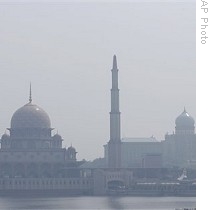Bangkok
06 August 2009
 |
| Putrajaya's landmark Putra Mosque (l) and Prime Minister's building seen covered by haze in Putrajaya, outside Kuala Lumpur, Malaysia, 06 Aug 2009 |
The Singapore Meteorological Services reported Thursday moderate to dense smoke from "large clusters of hotspots" in West Kalimantan in Indonesia and Sarawak in Malaysia. It also detected moderate smoke in the southern half of Sumatra island in Indonesia, as well as scattered hotspots in the provinces of East and Central Kalimantan.
Smoke from the fires has shrouded parts of Indonesia, Malaysia, Brunei and Singapore this week, causing airport disruptions and health complaints among residents. Visibility dropped so low Wednesday on the Indonesian island of Riau that flights had to be delayed or diverted because of safety concerns.
Aswin Usup heads the Research Center of Forest Fire Prevention and Rehabilitation at the University of Palangkaraya in Central Kalimantan province. He says using fire to clear the land is a traditional farming method on Borneo, the third largest island in the world.
"Unfortunately, in the dry season from July, August to September, wind direction is mainly coming from south to north. Therefore Singapore and Malaysia would have an impact on [from] the smoke," he explained.
Air quality has deteriorated in Malaysia this week. On Thursday morning, the Department of Environment said parts of Sarawak on Malaysian Borneo recorded "unhealthy" air pollution levels.
Malaysia's environment minister and his Indonesian counterpart will meet Saturday to address the issue. Haze has been a source of friction between Indonesia and its neighbors in recent years. Under the Association of Southeast Asian Nations, these countries have agreed to cooperate to reduce forest fires but haze continues to be a seasonal occurrence.
In Central Kalimantan, Aswin says his team has been teaching farmers to control fires, for example by not burning the entire land area at a single time to reduce smoke accumulation. But he says funding to sustain the campaign is a problem.
Fires release carbon dioxide into the atmosphere. Some scientists say increasing carbon dioxide levels contributes to climate change.
In addition, environmentalists say the fires destroy the habitat of some of the world's rarest animals, such as the orangutan and eastern Sumatran rhinoceros.